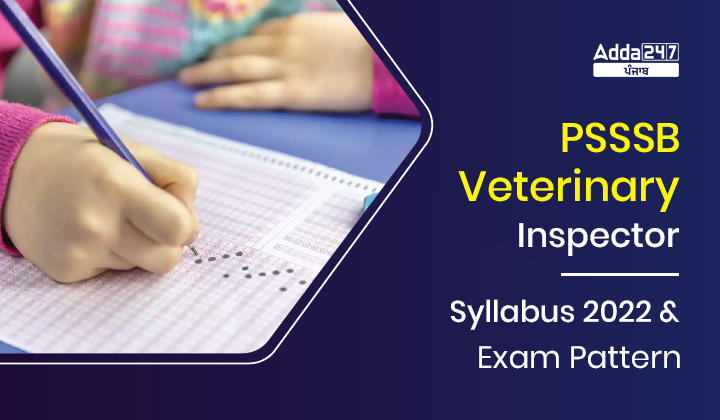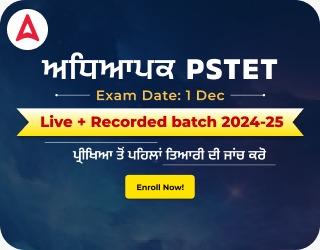PSSSB Veterinary Inspector Syllabus 2022: ਪੰਜਾਬ ਸੁਬਾਰਡੀਨੇਟ ਸਿਲੈਕਸ਼ਨ ਸਰਵਿਸ ਬੋਰਡ (PSSSB) ਨੇ ਵੈਟਰਨਰੀ ਇੰਸਪੈਕਟਰ ਭਰਤੀ 2023 ਦੇ ਅਹੁਦੇ ਲਈ ਦਸੰਬਰ ਮਹੀਨੇ ਵਿੱਚ ਇੱਕ ਨੋਟੀਫਿਕੇਸ਼ਨ ਜਾਰੀ ਕੀਤਾ। ਵੈਟਰਨਰੀ ਇੰਸਪੈਕਟਰਾਂ ਲਈ ਅਸਾਮੀਆਂ ਦੀ ਕੁੱਲ ਗਿਣਤੀ 254 ਹੈ। ਲਿਖਤੀ ਪ੍ਰੀਖਿਆ ਲਈ ਅੰਤਿਮ ਯੋਜਨਾ ਦੀ ਜਾਂਚ ਕਰੋ। ਇਸ ਵਿੱਚ PSSSB ਪੰਜਾਬ ਪਟਵਾਰੀ ਇਮਤਿਹਾਨ 2023 ਲਈ ਸਿਲੇਬਸ, ਇਮਤਿਹਾਨ ਪੈਟਰਨ, PDF, ਸੁਝਾਅ ਅਤੇ ਟ੍ਰਿਕਸ ਬਾਰੇ ਪੂਰੀ ਜਾਣਕਾਰੀ ਸ਼ਾਮਲ ਹੈ। ਆਓ PSSSB ਪੰਜਾਬ ਪਟਵਾਰੀ ਸਿਲੇਬਸ ਅਤੇ ਪ੍ਰੀਖਿਆ ਪੈਟਰਨ 2022 ਨੂੰ ਇੱਕ-ਇੱਕ ਕਰਕੇ ਸਮਝੀਏ।
PSSSB Veterinary Inspector Syllabus 2022: Overview
PSSSB Veterinary Inspector Syllabus 2022: Punjab Subordinate Service Selection Board (PSSSB) in the latest announcement has declared 254 vacancies for the post of Veterinary Inspector with a pay scale of 29,500/- per month. All interested candidates can check this detailed article to fulfill all the requirements related to PSSSB Veterinary Inspector Syllabus 2022.
| PSSSB Veterinary Inspector Recruitment 2022-23 | |
| Recruitment Board | Punjab Subordinate Service Selection Board (PSSSB) |
| Advt. No. | 17/2022 |
| Post Name | Veterinary Inspector |
| Vacancies | 254 Posts |
| Category | Syllabus and Exam Pattern |
| Pay Scale | 29,500/- |
| Last Date to Apply online | 12 January 2023 |
| Exam Date | To be Expected in January 2023 |
| Job Location | Punjab |
| website | https://sssb.punjab.gov.in/ |
PSSSB Veterinary Inspector Syllabus 2022: Subject-wise
PSSSB Veterinary Inspector Syllabus 2022: ਜੋ ਉਮੀਦਵਾਰ PSSSBVeterinary Inspector Exam 2022 ਲਈ ਹਾਜ਼ਰ ਹੋ ਰਹੇ ਹਨ, ਉਹ ਪ੍ਰੀਖਿਆ ਲਈ ਹੇਠਾਂ ਦਿੱਤੇ ਸਿਲੇਬਸ ਦੀ ਜਾਂਚ ਕਰ ਸਕਦੇ ਹਨ। PSSSBVeterinary Inspector subject-wise Syllabus ਨੂੰ ਵਿਸਥਾਰ ਵਿੱਚ ਦੇਖੋ:
Part-A (Punjabi Qualifying Exam) Syllabus
- ਜੀਵਨੀ ਅਤੇਰਚਨਾਵਾਾ ਨਾਲ ਸਬੰਧਤ ਪ੍ਰਸ਼ਨ:-
- ਸ਼੍ਰੀ ਗੁਰੂ ਨਾਨਕ ਦੇਵ ਜੀ, ਸ਼੍ਰੀ ਗੁਰੂ ਅੰਗਦ ਦੇਵ ਜੀ, ਸ਼੍ਰੀ ਗੁਰੂ ਰਾਮਦਾਸ ਜੀ,
- ਸ਼੍ਰੀ ਗੁਰੂ ਅਰਜਨ ਦੇਵ ਜੀ, ਸ਼੍ਰੀ ਗੁਰੂ ਤੇਗ ਬਹਾਦਰ ਜੀ, ਸ਼੍ਰੀ ਗੁਰੂ ਗੋਬਿੰਦ ਸਿੰਘ ਜੀ।
- ਸਮਾਨਾਰਥਕ ਸ਼ਬਦ।
- ਮੁਹਾਵਰੇ।
- ਅਖਾਣ
- ਸਬਦ ਦੇ ਭੇਦ।
- ਅਗੇਤਰ/ਪਿਛੇਤਰ।
- ਵਚਨ ਬਦਲੋ ਤੇ ਲਿੰਗ ਬਦਲੋ।
- ਵਿਸ਼ਰਾਮ ਚਿੰਨ੍ਹ।
- ਸ਼ਬਦਾ/ ਵਾਕਾ ਨੂੰ ਸ਼ੁੁੱਧ ਕਰਕੇ ਲਿਖੋ।
- ਅੰਗਰੇਜ਼ੀ ਸ਼ਬਦਾ ਦਾ ਪੰਜਾਬੀ ਵਿੱਚ ਸ਼ੁੁੱਧ ਰੂਪ।
- ਅੰਕਾਂ, ਮਹੀਨੇ, ਦਾ ਸ਼ੁੁੱਧ ਪ੍ੰਜਾਬੀ ਰੂਪ੍।
- ਪ੍ੰਜਾਬੀ ਭਾਸ਼ਾ ਨਾਲ ਸਬੰਧਤ ਪ੍ਰਸ਼ਨ।
- ਪ੍ੰਜਾਬ ਦੇ ਇਤਿਹਾਸ ਨਾਲ ਸਬੰਧਤ ਪ੍ਰਸ਼ਨ।
- ਪ੍ੰਜਾਬ ਦੇ ਸਭਿਆਚਾਰ ਨਾਲ ਸਬੰਧਤ ਪ੍ਰਸ਼ਨ।
Part-B (1 Subject Syllabus )
- Elementary Animal Husbandry
Common breeds of cattle, buffalo, sheep, goat, pig, horse, and poultry; Animal production systems; Principles of housing for farm animals; Routine management practices for various categories of livestock (calves, heifers, pregnant and lactating animals, etc.) and sick animals; Introduction to methods of castration; Milking techniques; Clean milk production concept, significance and factors affecting clean milk production; Sanitation and hygiene practices; Routine farm practices including wallowing, watering and bathing; Record keeping and responsibilities of veterinary inspector/ para-veterinarian; waste management, Identification techniques in animals, Bio-security methods at livestock farm. - Elementary Livestock Handling
An overview of animal behaviour, Common tools used for animal control; Methods of restraining and handling of animals; Dentition, Farrier practices, and shoeing, Hoof trimming in bovine; Prevention of cruelty to animals, Preparing animals for show/animal fair. - Elementary Animal Nutrition
Principles of animal nutrition; Digestive systems including rumination; Nutritional importance of carbohydrates, lipids, proteins, vitamins, minerals, and water; Common feeds and fodders; Scientific feeding and feeding schedule for different categories of livestock; Colostrums feeding- How, when and why to feed colostrums to calves? Feeding practice of cow & buffalo-Ration balancing; Anti-nutritional factors; Feed additives; Hay and Silage making, Precautions in the storage of feed and fodder. - Basic Computer Applications
Knowledge about computer accessories. Use of computers in handling and presenting veterinary and livestock data. Working in Windows operating system. Working with MS Word, and Spreadsheets using MS Excel, Graphics, and MS PowerPoint. Internet and World Wide Web, E-mail and internet services; Computer viruses, antivirus. Practice in Farm data recording. - Elementary Anatomy and Physiology of Animals
Introduction to anatomy and physiology of musculoskeletal, digestive, cardiovascular, respiratory, nervous, excretory, male and female reproductive and endocrine systems; Mammary glands of domestic animals; Body cavities (Thoracic, abdominal, and Pelvic) and their related organs. Basic physiological parameters of domestic animals. - Elementary Pharmacology
Introduction to Pharmacology, Nature, and sources of drugs; Routes of drug administration; Dosage forms; Pharmaceutical processes; Handling of hazardous substances; Common antiseptics and disinfectants; Weights and measures; Pharmacy calculations; Classification of important drugs; Important Indigenous and allopathic drugs. - Elementary Veterinary Epidemiology and Public Heath
Introduction to epidemiology, surveillance, and monitoring of common seasonal infectious diseases like Brucellosis, Rabies, Cysticercosis, TB, JD, Anthrax, FMD, Foodborne pathogens, Public health considerations; Common zoonoses and their management; Disposal of a cadaver; Concept of contagious, notifiable diseases and outbreaks. - Elementary Poultry Science
Poultry types-Layer, Broilers; Common breeds/strains of poultry; Meat, and egg productivity, and production, Different housing/rearing systems; Management
of layer and broiler farm; Brooding; Hatchery routines; Cleaning of poultry sheds and litter management; Bio-security; Feeding and poultry ration; Introduction to common poultry diseases; Vaccination. - Elementary Animal Husbandry Extension
Extension in rural welfare; Community development and rural sociology; Principles and objectives of veterinary and animal husbandry extension; Qualities of extension worker; Extension teaching methods; Extension and training programmers. Duties of veterinary inspector/ para-veterinarian; Communication tools and Role of media, Set-up of Animal Husbandry Department, Record maintenance at Veterinary Hospital, Government schemes for farmer’s benefits. - Elementary Animal Reproduction
Female genitalia of cattle, buffalo, and goats, Reproductive cycle, Puberty, Oestrous cycle; Methods of heat detection including fern pattern; Gestation in domestic animals; Methods of pregnancy diagnosis; Abortion in domestic animals; Parturition and impending signs, Types of infertility in farm animals causes and remedies; Sexual health and herd health program; Care and management of dam and newborn calf, Introduction to parturient problems in dairy animals. - Elementary Andrology and Artificial Insemination
Study of male genitalia and gonads; Puberty, Methods of semen collection and storage; Handling of fresh/frozen semen; Artificial insemination including optimum time of AI; Diseases transmitted through semen. - Elementary Parasitology
Introduction to common parasites I.e., protozoa (Theileria, Babesia, Anaplasma, and Trypanosomes), Tremetodes (Liver flukes, amphistomes, and lung flukes), cestodes (Moneizia, Dipylidiumcaninum, Taeniasis, Hydatid cyst), nematodes (Toxocare, Hemonchus, Lungworm, filarial nematodes, etc) and arthropods (Flies, Ticks, Mites, Fleas, and myiasis) in livestock; Economic importance of parasitic diseases of livestock. - Procurement, Handling, and Testing of milk
History of dairy development in India. Three-tier structure of dairy cooperative. An introduction to the Indian dairy industry with special reference to the dairy sector in
Punjab. Milk- definition, its composition, factors affecting the quality of milk, and standards. Milk collection systems and their handling (transportation, reception, and storage). Platform tests for quality analysis of milk. Important sanitary and hygienic practices for milk handling. Cleaning and its importance. Introduction to common detergents & sanitary agents. Milk pricing system and its concept. - Basic Livestock Health Management
Introduction to common diseases of livestock; Hemorrhagic Septicaemia. Brucellosis, Tuberculosis, Foot and Mouth disease, Rabies, Johne’s disease, Glanders, Theileriosis, Classical swine fever, etc. Insecticide toxicities. Preventive health measures for bacterial, viral, and parasitic diseases in various species. - Veterinary Hospital Maintenance
Maintenance of case record and log books of scheduled drugs Basic accounting; Preparation of bills and maintenance of a consumable and non-consumable stock of hospital; History taking, Prescription reading and dispensing of drugs, Preparation of animals for surgical operation; Care and maintenance of surgical, anesthetic and other common equipment; Assisting veterinary surgeon in post-operative care; Hospital hygiene, Sterilization of operation theatre; Surgical pack and surgical instruments; Types of suture material, Categorization of biomedical waste, its disposal as per pollution control board regulations. - Elementary Veterinary Medicine
Introduction to digestive, respiratory, urinary, and production systems and their diseases (Milk fever, Ketosis; Haemoglobinuria); Preliminary knowledge about
indigestion, bloat, constipation, diarrhea, aspiration pneumonia and urinary incontinence, Mastitis; Common mineral and vitamin deficiencies, Hoof care. - Elements of Wound care and Management
Wound causes, classification; Types of wound dressings; Basic concepts of abscess, ulcers, hematoma, cyst, tumor, and hernia; Clinical use of antiseptics, fly repellents, anti-maggot, etc.; First aid in sick animals including fracture cases. Management of bloat; Hoof care. - Basic Clinical Pathology and Laboratory techniques
Handling of laboratory equipment, glassware, and chemicals; Cleaning and sterilizing of laboratory wares; Basic microscopy principles; Blood collection techniques; Use of anticoagulants; Serum and plasma separation; Urine collection, preservation, and common physical and chemical tests; Collection, preservation and dispatch of tissues for histopathology, Protocols for a necropsy of mammals and poultry birds. - Practical On-Farm/Farmer’s Door Training
Handling, and management practices of Dairy farms, Stud farms, Poultry farms, Piggery farms, Sheep and Goat farm, Routine farm operations including vaccination, etc. Communication with farmers; Use of audio and visual aids for training for farmers; Organizing farmer interactions, Extension programs viz. KisanMela, Livestock shows, Animal markets, and Animal welfare camps. - Practical In-Clinics Training
Handling and dealing with sick animals, Record keeping; History taking; Sampling of body fluid/tissues; Medication; Pos-operative management of surgical patients; Care of pregnant animals; Vaccination; Preparation of solutions, lotions, tinctures, ointments, mixtures (carminatives, laxatives, purgatives, febrifuge, etc.) Electuaries etc. - Practical Lab/Hospital Training
Handling of laboratory equipment; Methodology for transporting various samples to the laboratory for examination; Blood smear preparation; Staining; Complete blood count; Serum and plasma separation; Preservations of serum, plasma, and tissues; Urine examination; Preparation of smears for fecal examination. - Practical Bull Centre Training
Management of breeding bull; preparation of dummy; Artificial vagina preparation; Preparation of extenders; Handling of chilled and frozen semen, Storage of semen; Handling of liquid nitrogen including its containers; Artificial insemination; Record keeping
Part-B ( 2. General Knowledge, Logical Reasoning and Mental Ability, English and Punjabi.)
| Indicative Contents of Syllabus | Weightage |
| General Knowledge and Current affairs of National and International importance includes: (i) Political issues, (ii) Environment issues, (iii) Current Affairs, (iv) Science and Technology, (v) Economic issues, (vi) History of Punjab-14th century onwards (vii) History of India with special reference to Indian freedom struggle movement. (viii) Sports, (ix) Cinema and Literature |
10 |
| Logical Reasoning & Mental Ability: Verbal reasoning: Coding, Decoding, Analogy, Classification, Series, Direction sense test, relations, mathematical operations, time test, the odd man out problems. Non-Verbal Reasoning: Series, Analogy, and Classification. Basic numerical skills, Percentage, Number system, LCM, and HCF, Ratio and Proportion, Number series, Average, Problems based on Ages, Profit & Loss, Partnership and Mixture, Simple and Compound Interest, Work and Time, Time and Distance. Mensuration and Data Interpretation. |
10 |
| English:- Basic Grammar, Subject and Verb, Adjectives and Adverbs, Synonyms, Antonyms, One Word Substitution, Fill in the Blanks, Correction in Sentences, Idioms and their meanings, Spell Checks, Adjectives, Articles, Prepositions, Direct and Indirect Speech, Active and Passive Voice, Correction in Sentences, etc. |
05 |
| ਪੰਜਾਬੀ:- ਸ਼ੁੱਧ-ਅਸ਼ੁੱਧ, ਸ਼ਬਦਜੋੜ, ਅਗੇਤਰ ਅਤੇ ਪਿਛੇਤਰ, ਸਮਾਨਾਰਥਕ/ਵਿਰੋਧੀਸ਼ਬਦ, ਨਾਂਵ, ਪੜਨਾਂਵ ਅਤੇ ਕਿਰਿਆ ਦੀਆਂ ਕਿਸਮਾਂ ਤੇਸਹੀ ਵਰਤੋਂ, ਲਿੰਗ ਅਤੇਵਚਨ, ਪੰਜਾਬੀ ਅਖਾਣ ਤੇ ਮੁਹਾਵਰੇ, ਅੰਗਰੇਜੀ ਤੋਂ ਪੰਜਾਬੀ ਅਨੁਵਾਦ ਅਤੇ ਬਹੁਤੇ ਸ਼ਬਦਾਂ ਦੀ ਥਾਂ ਇੱਕ ਸ਼ਬਦ ਆਦਿ। |
05 |
| Maximum Marks | 30 |
Note:-a) The distribution of marks/question in each section is indicative. It may vary slightly.
b) The syllabus is broadly classified as above but may vary to some extent.
Enroll yourself: Punjab Ka Maha Pack 12-month Validity
Get a Complete List of Punjab Govt Exam Under one Package with huge Discounts of up to 75% with 12 Months of Validity. Click here to Know more
PSSSB Veterinary Inspector Syllabus 2022: Exam Pattern
PSSSB Veterinary Inspector Exam Pattern 2022: ਜਿਹੜੇ ਉਮੀਦਵਾਰ PSSSB Veterinary Inspector 2022-23 ਲਈ ਹਾਜ਼ਰ ਹੋ ਰਹੇ ਹਨ, ਉਹ Veterinary Inspector Exam 2022 ਦੀ ਪ੍ਰੀਖਿਆ ਪੈਟਰਨ ਦੀ ਜਾਂਚ ਕਰ ਸਕਦੇ ਹਨ।ਲਿਖਤੀ ਪ੍ਰੀਖਿਆ ਲਈ ਪ੍ਰੀਖਿਆ ਪੈਟਰਨ ਹੇਠਾਂ ਦਿੱਤੀ ਸਾਰਣੀ ਵਿੱਚ ਦਰਸਾਇਆ ਗਿਆ ਹੈ:
Part A ਕੋਈ ਨੈਗੇਟਿਵ ਮਾਰਕਿੰਗ ਨਹੀਂ ਹੋਵੇਗੀ।
Part B ਦਾ ਮੁਲਾਂਕਣ ਤਾਂ ਹੀ ਕੀਤਾ ਜਾਵੇਗਾ ਜੇਕਰ ਕੋਈ ਉਮੀਦਵਾਰ ਘੱਟੋ-ਘੱਟ ਅੰਕ ਪ੍ਰਾਪਤ ਕਰਦਾ ਹੈ। ਭਾਗ B ਵਿੱਚ 50% ਅੰਕ ( ਭਾਵ – 25 ਅੰਕ)
Part- A
| Topic | No. of question | Marks | Type of Questions |
| Punjabi (Qualifying Nature) (Annexure1) | 50 | 50 | MCQs (Multiple Choice Questions) |
- Part A ਕੋਈ ਨੈਗੇਟਿਵ ਮਾਰਕਿੰਗ ਨਹੀਂ ਹੋਵੇਗੀ।
- Part B ਦਾ ਮੁਲਾਂਕਣ ਤਾਂ ਹੀ ਕੀਤਾ ਜਾਵੇਗਾ ਜੇਕਰ ਕੋਈ ਉਮੀਦਵਾਰ ਘੱਟੋ-ਘੱਟ ਅੰਕ ਪ੍ਰਾਪਤ ਕਰਦਾ ਹੈ। ਭਾਗ B ਵਿੱਚ 50% ਅੰਕ ( ਭਾਵ – 25 ਅੰਕ)
Part B
| Section | Topic | No. of Questions | Marks | Type of question |
| 1. | Questions from the Subject (Part 2) | 70 | 70 | MCQs ( multiple choice questions) |
| 2. | Questions from Questions) General Knowledge, English, Logical Reasoning and Mental ability, Punjabi (Part-3) | 30 | 30 | |
| Total | 100 | 100 | ||
- Part B ਵਿੱਚ ਨਕਾਰਾਚਮਕ ਮਾਰਕਿੰਗ ਹੋਵੇਗੀ। ਹਰੇਕ ਸਵਾਲ ਵਿੱਚ 1 ਹੁੰਦਾ ਹੈ। ਨਿਸ਼ਾਨ ਹਰ ਜਵਾਬ ਲਈ, 1/4 ਅੰਕ ਕੱਟਿਆ ਜਾਵੇਗਾ। ਕੋਸ਼ੀਸ਼ ਨਹੀ ਕੀਤੇ ਗਏ ਸਵਾਲਾਂ ਨੂੰ ਕੋਈ ਕ੍ਰੈਡਿਟ ਜਾਂ ਬਦਨਾਮ ਨਹੀ ਮਿਲੇਗਾ।
- ਉਮੀਦਵਾਰਾਂ ਦੀ ਮੈਰਿਟ ਸੂਚੀ ਜੋ ਭਾਗ ‘ਏ’ ਲਈ ਯੋਗ ਹੋਣਗੇ, ਹੋਵੇਗੀ। ਭਾਗ-ਬੀ ਵਿੱਚ ਉਮੀਦਵਾਰ ਦੁਆਰਾ ਪ੍ਰਾਪਤ ਅੰਕਾਂ ਦੇ ਆਧਾਰ ‘ਤੇ ਤਿਆਰ ਕੀਤਾ ਗਿਆ ਹੈ।
PSSSB Veterinary Inspector Syllabus 2022: Download PDF
PSSSB Veterinary Inspector Syllabus 2022: ਉਮੀਦਵਾਰ ਹੇਠਾਂ ਦਿੱਤੇ ਲਿੰਕ ਰਾਹੀਂ PSSSB Veterinary Inspector Syllabus PDF ਨੂੰ ਡਾਊਨਲੋਡ ਕਰ ਸਕਦੇ ਹਨ। ਇਸ PDF ਵਿੱਚ PSSSB Veterinary Inspector 2022 ਦਾ ਪੂਰਾ ਸਿਲੇਬਸ ਅਤੇ ਪ੍ਰੀਖਿਆ ਪੈਟਰਨ PSSSB ਦੀ ਅਧਿਕਾਰਤ ਅਥਾਰਟੀ ਦੁਆਰਾ ਦਿੱਤਾ ਗਿਆ ਹੈ। ਹੇਠਾਂ ਦਿੱਤੇ ਲਿੰਕ ‘ਤੇ ਕਲਿੱਕ ਕਰੋ:
Click Here to Download: PSSSB Veterinary Inspector Syllabus and Exam Pattern 2022
PSSSB Veterinary Inspector Syllabus 2022: Tips and Tricks
PSSSB Veterinary Inspector Syllabus 2022: ਜੋ ਵੀ ਉਮੀਦਵਾਰ PSSSB Veterinary Inspector Exam 2022 ਪਾਸ ਕਰਨਾ ਚਾਹੁੰਦੇ ਹਨ ਉਹਨਾਂ ਲਈ ਸਾਡੇ ਵਲੋਂ ਕੁਛ Tips ਅਤੇ Tricks ਹੇਠਾਂ ਦਿੱਤੀਆਂ ਗਈਆਂ ਹਨ:
- PSSSB Veterinary Inspector Exam 2022-23 ਪਾਸ ਕਰਨ ਲਈ ਸਭ ਤੋਂ ਪਹਿਲਾਂ PSSSB Veterinary Inspector Syllabus and Exam pattern 2022 ਵਿਸਥਾਰ ਵਿੱਚ ਦੇਖਣਾ ਅਤੇ ਸਮਝਣਾ ਚਾਹੀਦਾ ਹੈ।
- ਇੱਕ ਚੰਗਾ Study Plan ਬਣਾ ਕੇ ਤਿਆਰੀ ਕਰਨ ਨਾਲ ਇਕਸਾਰਤਾ ਬਣੀ ਰਹੇਗੀ। ਜਿਸ ਨਾਲ PSSSB Veterinary Inspector Syllabus and Exam pattern 2022 ਦੇ ਹਰ ਇੱਕ ਵਿੱਸ਼ੇ ਲਈ ਸਮਾਂ ਦਿੱਤਾ ਜਾ ਸਕੇਗਾ।
- ਇਸ ਤੋਂ ਬਿਨਾਂ ਉਮੀਦਵਾਰਾਂ ਨੂੰ ਚੰਗੇ Resource Follow ਕਰਕੇ ਹੀ ਪੜਨਾ ਚਾਹੀਦਾ ਹੈ।
- ਆਪਣੇ ਮਜਬੂਤ ਅਤੇ ਕਮਜੋਰ ਪੱਖ ਲਭੋ।
- ਇਹਨਾਂ ਸਭ Tips and Tricks ਨਾਲ ਤੁਸੀਂ PSSSB Veterinary Inspector Exam 2022 ਪਾਸ ਕਰ ਸਕੋਗੇ।
PSSSB Veterinary Inspector Syllabus 2022: FAQs

Q. PSSSB Veterinary Inspector Syllabus 2022-23 ਕੀ ਹੈ?
Ans. PSSSB Veterinary Inspector Syllabus ਵਿੱਚ ਆਮ ਗਿਆਨ/ਜਾਗਰੂਕਤਾ (ਭਾਰਤ ਅਤੇ ਪੰਜਾਬ), ਭਾਸ਼ਾਵਾਂ (ਪੰਜਾਬੀ/ਅੰਗਰੇਜ਼ੀ), ਅਤੇ ਵਿਸ਼ੇ ਵਿਸ਼ੇਸ਼ ਸ਼ਾਮਲ ਹਨ।
Q. ਮੈਂ PSSSB Veterinary Inspector Syllabus PDF ਕਿੱਥੋਂ ਡਾਊਨਲੋਡ ਕਰ ਸਕਦਾ/ਸਕਦੀ ਹਾਂ?
Ans. PSSSB Veterinary Inspector Syllabus PDF ਲਿੰਕ ਇਸ ਲੇਖ ਵਿੱਚ ਦਿੱਤਾ ਗਿਆ ਹੈ। ਲਿੰਕ ‘ਤੇ ਕਲਿੱਕ ਕਰੋ ਅਤੇ PSSSB Veterinary Inspector Syllabus PDF ਡਾਊਨਲੋਡ ਕਰੋ।
Q. ਕੀ PSSSB Veterinary Inspector exam 2022 ਦੇ ਤਹਿਤ ਕੋਈ ਨਕਾਰਾਤਮਕ ਮਾਰਕਿੰਗ ਹੈ?
Ans. ਹਾਂ, ਉਮੀਦਵਾਰਾਂ ਦੁਆਰਾ ਚਿੰਨ੍ਹਿਤ ਕੀਤੇ ਗਏ ਹਰੇਕ ਗਲਤ ਉੱਤਰ ਲਈ 1/4 ਦੀ negative marking ਹੋਵੇਗੀ।
Q. PSSSB Veterinary Inspector written exam ਵਿੱਚ ਲੋੜੀਂਦੀ ਘੱਟੋ-ਘੱਟ ਪ੍ਰਤੀਸ਼ਤਤਾ ਕਿੰਨੀ ਹੈ?
Ans. PSSSB Veterinary Inspector written exam ਲਈ ਘੱਟੋ-ਘੱਟ ਯੋਗਤਾ ਅੰਕ 40% ਹੈ।
Download Adda 247 App here to get the latest updates
Related Articles:
Read More:
| Latest Job Notification | Punjab Govt Jobs |
| Current Affairs | Punjab Current Affairs |
| GK | Punjab GK |













